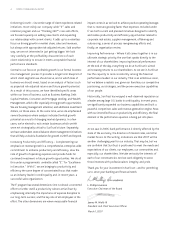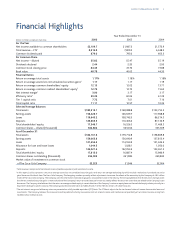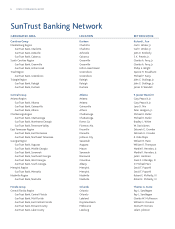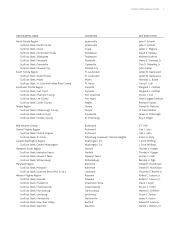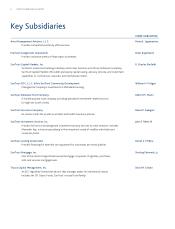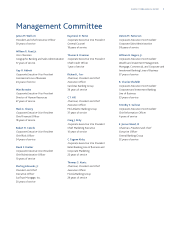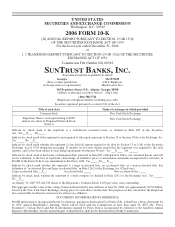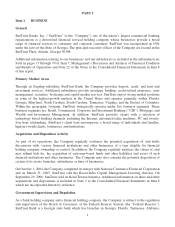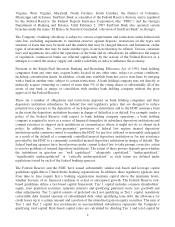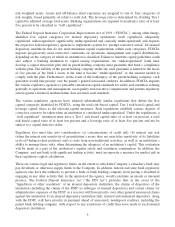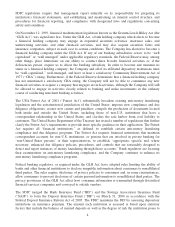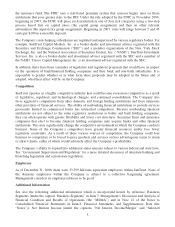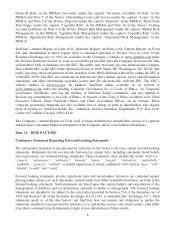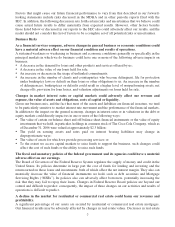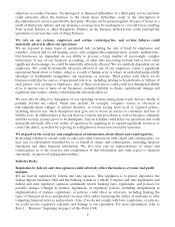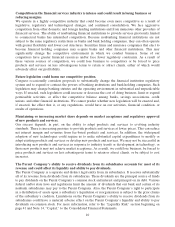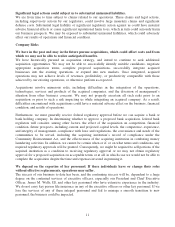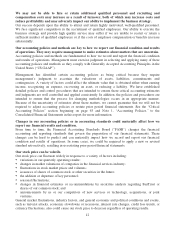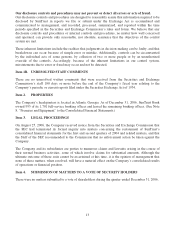SunTrust 2006 Annual Report Download - page 16
Download and view the complete annual report
Please find page 16 of the 2006 SunTrust annual report below. You can navigate through the pages in the report by either clicking on the pages listed below, or by using the keyword search tool below to find specific information within the annual report.risk-weighted assets. Assets and off-balance sheet exposures are assigned to one of four categories of
risk-weights, based primarily on relative credit risk. The leverage ratio is determined by dividing Tier 1
capital by adjusted average total assets. Banking organizations are required to maintain a ratio of at least
five percent to be classified as “well capitalized.”
The Federal Deposit Insurance Corporation Improvement Act of 1991 (“FDICIA”), among other things,
identifies five capital categories for insured depository institutions (well capitalized, adequately
capitalized, undercapitalized, significantly undercapitalized and critically undercapitalized) and requires
the respective federal regulatory agencies to implement systems for “prompt corrective action” for insured
depository institutions that do not meet minimum capital requirements within such categories. FDICIA
imposes progressively more restrictive constraints on operations, management and capital distributions,
depending on the category in which an institution is classified. Failure to meet the capital guidelines could
also subject a banking institution to capital raising requirements. An “undercapitalized” bank must
develop a capital restoration plan and its parent holding company must guarantee that bank’s compliance
with the plan. The liability of the parent holding company under any such guarantee is limited to the lesser
of five percent of the bank’s assets at the time it became “undercapitalized” or the amount needed to
comply with the plan. Furthermore, in the event of the bankruptcy of the parent holding company, such
guarantee would take priority over the parent’s general unsecured creditors. In addition, FDICIA requires
the various regulatory agencies to prescribe certain non-capital standards for safety and soundness relating
generally to operations and management, asset quality and executive compensation and permits regulatory
action against a financial institution that does not meet such standards.
The various regulatory agencies have adopted substantially similar regulations that define the five
capital categories identified by FDICIA, using the total risk-based capital, Tier 1 risk-based capital and
leverage capital ratios as the relevant capital measures. Such regulations establish various degrees of
corrective action to be taken when an institution is considered undercapitalized. Under the regulations, a
“well capitalized” institution must have a Tier 1 risk-based capital ratio of at least six percent, a total
risk-based capital ratio of at least ten percent and a leverage ratio of at least five percent and not be
subject to a capital directive order.
Regulators also must take into consideration: (a) concentrations of credit risk; (b) interest rate risk
(when the interest rate sensitivity of an institution’s assets does not match the sensitivity of its liabilities
or its off-balance-sheet position); and (c) risks from non-traditional activities, as well as an institution’s
ability to manage those risks, when determining the adequacy of an institution’s capital. This evaluation
will be made as a part of the institution’s regular safety and soundness examination. In addition, the
Company, and any bank with significant trading activity, must incorporate a measure for market risk in
their regulatory capital calculations.
There are various legal and regulatory limits on the extent to which the Company’s subsidiary bank may
pay dividends or otherwise supply funds to the Company. In addition, federal and state bank regulatory
agencies also have the authority to prevent a bank or bank holding company from paying a dividend or
engaging in any other activity that, in the opinion of the agency, would constitute an unsafe or unsound
practice. The Federal Deposit Insurance Act (“the FDI Act”) provides that, in the event of the
“liquidation or other resolution” of an insured depository institution, the claims of depositors of the
institution (including the claims of the FDIC as subrogee of insured depositors) and certain claims for
administrative expenses of the FDIC as a receiver will have priority over other general unsecured claims
against the institution. If an insured depository institution fails, insured and uninsured depositors, along
with the FDIC, will have priority in payment ahead of unsecured, nondeposit creditors, including the
parent bank holding company, with respect to any extensions of credit they have made to such insured
depository institution.
3


